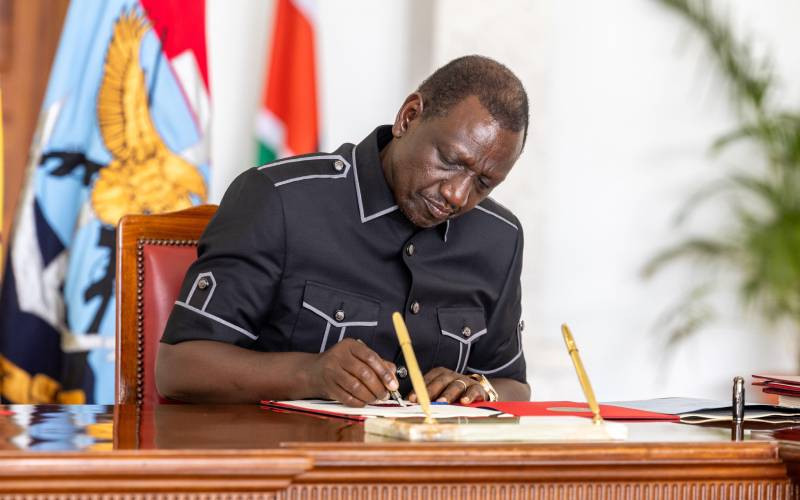Achim Steiner
Forty years ago, in the Swedish capital Stockholm, history was made at a UN conference on the future of humanity and the planet that would propel Kenya into the centre of international environmental affairs. Amid rising concern over pollution, the land and the seas; the growing loss of species and the dying of forests as a result of acid rain, governments agreed that a UN body charged with coordinating a global response to such challenges should be established.
In June 1972 at the UN General Assembly countries lobbied to have this new environmental body. But in the end Kenya won the diplomatic battle and became the first developing country to host a UN headquarters. Founding President Jomo Kenyatta attended the inaugural celebrations on October 2, 1973. A Canadian, Maurice Strong, Unep’s first Executive Director, was present. Unep was originally set up to coordinate the rest of the UN system’s activities on environmental issues and to provide the science to member states on emerging trends in environmental change.
The emphasis on science has perhaps been among the organisation’s most important contributions that in turn has led to governments negotiating key global treaties to address emerging environmental crises. The Montreal Protocol on Substances that Deplete the Ozone layer – the protective shield that filters out dangerous levels of the sun’s ultra violet rays – is a case in point. It became clear in the 1980s that certain chemicals used in products such as fridges to fire-fighting equipment were attacking the ozone layer.
By 2010, this Unep treaty had coordinated the phase-out of over 100 of these harmful gases. Recently, governments from across the world met in Gigiri, Nairobi, to push forward plans for a global agreement on mercury – a heavy metal that damages the nervous system.
In 1990s, as the world was struggling to understand the implications of rising greenhouse gases in the atmosphere, Unep and the World Meteorological Organisation established the Inter-governmental Panel on Climate Change.
Its scientific work has become the premier risk assessment and reference for governments on the likely trends and impacts of global warming and the Panel’s findings played a key role in the decision to establish the UN climate convention and its emission reduction treaty, the Kyoto Protocol. Following the famous Earth Summit of 1992, Unep was given more opportunities to evolve its work as an implementing agency of a new multi-billion dollar fund, the Global Environment Facility.
The expansion of geothermal electricity in the Great Rift Valley has been made possible by Unep, to bring in new, more reliable and cost effective drilling techniques. Since 2008, the organisation has been championing the green economy to generate growth and employment that keeps humanity’s footprint within ecological boundaries. Part of that work has been to assess and communicate to governments services that nature provides. At the World Summit on Sustainable Development in Johannesburg in 2002, Unep was asked to spearhead a partnership in order to finish off a global phase-out of leaded petrol: Lead is especially damaging to the brain of infants and the young.
So what of the future? As environment ministers gather in Nairobi for their annual meeting of the Unep Governing Council in February, all eyes are on the follow up to the Earth Summit of 1992. Rio+20, taking place in June, may prove to be an opportunity where the green economy initiative is translated into a fresh and forward-looking way of finally realising sustainable development.
Some governments, including Kenya and Germany are also signalling that the time has come to strengthen Unep into a World Environment Organisation. Whether June will evolve the Unep story into a higher level, only time will tell.
Writer is UN Under Secretary General and Unep Executive Director.
 The Standard Group Plc is a
multi-media organization with investments in media platforms spanning newspaper
print operations, television, radio broadcasting, digital and online services. The
Standard Group is recognized as a leading multi-media house in Kenya with a key
influence in matters of national and international interest.
The Standard Group Plc is a
multi-media organization with investments in media platforms spanning newspaper
print operations, television, radio broadcasting, digital and online services. The
Standard Group is recognized as a leading multi-media house in Kenya with a key
influence in matters of national and international interest.
 The Standard Group Plc is a
multi-media organization with investments in media platforms spanning newspaper
print operations, television, radio broadcasting, digital and online services. The
Standard Group is recognized as a leading multi-media house in Kenya with a key
influence in matters of national and international interest.
The Standard Group Plc is a
multi-media organization with investments in media platforms spanning newspaper
print operations, television, radio broadcasting, digital and online services. The
Standard Group is recognized as a leading multi-media house in Kenya with a key
influence in matters of national and international interest.








